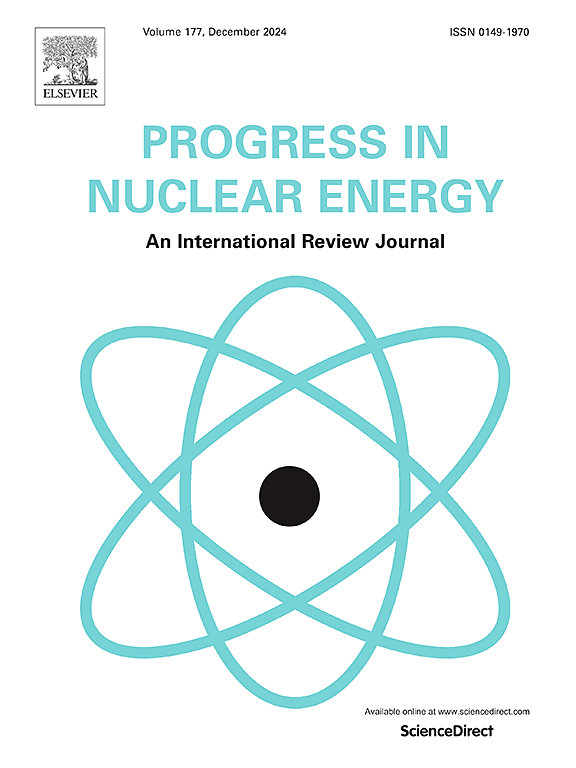压水堆事故预测中定量参数重要性和运行阈值的可解释机器学习
IF 3.2
3区 工程技术
Q1 NUCLEAR SCIENCE & TECHNOLOGY
引用次数: 0
摘要
机器学习模型的“黑箱”性质阻碍了核安全系统的信任和透明度,而可解释性至关重要。本文介绍了一种可解释的CatBoost-SHAP框架,用于压水堆事故预测。利用CPR1000反应器模拟器和optuna优化的CatBoost,该模型实现了高精度(R2 >;0.999, MAPE & 1%),在热腿和冷腿场景下的小断裂冷却剂损失事故(SBLOCA)数据集上,优于XGBoost和LightGBM。SHAP分析确定了关键的热液驱动因素(例如,蒸汽发生器(SG)压力<;6.74 MPa,大范围降水管液位<; - 1.4%),并揭示了多回路变量之间的非线性相互作用,与反应堆物理特性一致。该框架的双重能力——高预测精度和机制可解释性——使操作人员能够验证决策路径并优先考虑安全阈值。通过弥合不透明的人工智能与核安全需求之间的差距,这项工作为压水堆的实时诊断和主动事故缓解提供了实用指南。本文章由计算机程序翻译,如有差异,请以英文原文为准。
Interpretable machine learning for quantitative parameter importance and operational thresholds in PWR accident prediction
The "black box" nature of machine learning models hinders trust and transparency in nuclear safety systems, where interpretability is critical. This study introduces an explainable CatBoost-SHAP framework for accident prediction in pressurized water reactors (PWRs). Leveraging CPR1000 reactor simulator and Optuna-optimized CatBoost, the model achieved high accuracy (R2 > 0.999, MAPE <1 %) on small break loss-of-coolant accident (SBLOCA) datasets for both hot-leg and cold-leg scenario, outperforming XGBoost and LightGBM. SHAP analysis identified key thermal-hydraulic drivers (e.g., steam generator (SG) pressure <6.74 MPa, wide-range downcomer level <−1.4 %) and uncovered nonlinear interactions among multi-loop variables, consistent with reactor physics. The framework's dual capability - high predictive precision and mechanistic interpretability - enables operators to validate decision pathways and prioritize safety thresholds. By bridging the gap between opaque AI and nuclear safety demands, this work provides practical guidelines for real-time diagnostics and proactive accident mitigation in PWRs.
求助全文
通过发布文献求助,成功后即可免费获取论文全文。
去求助
来源期刊

Progress in Nuclear Energy
工程技术-核科学技术
CiteScore
5.30
自引率
14.80%
发文量
331
审稿时长
3.5 months
期刊介绍:
Progress in Nuclear Energy is an international review journal covering all aspects of nuclear science and engineering. In keeping with the maturity of nuclear power, articles on safety, siting and environmental problems are encouraged, as are those associated with economics and fuel management. However, basic physics and engineering will remain an important aspect of the editorial policy. Articles published are either of a review nature or present new material in more depth. They are aimed at researchers and technically-oriented managers working in the nuclear energy field.
Please note the following:
1) PNE seeks high quality research papers which are medium to long in length. Short research papers should be submitted to the journal Annals in Nuclear Energy.
2) PNE reserves the right to reject papers which are based solely on routine application of computer codes used to produce reactor designs or explain existing reactor phenomena. Such papers, although worthy, are best left as laboratory reports whereas Progress in Nuclear Energy seeks papers of originality, which are archival in nature, in the fields of mathematical and experimental nuclear technology, including fission, fusion (blanket physics, radiation damage), safety, materials aspects, economics, etc.
3) Review papers, which may occasionally be invited, are particularly sought by the journal in these fields.
 求助内容:
求助内容: 应助结果提醒方式:
应助结果提醒方式:


